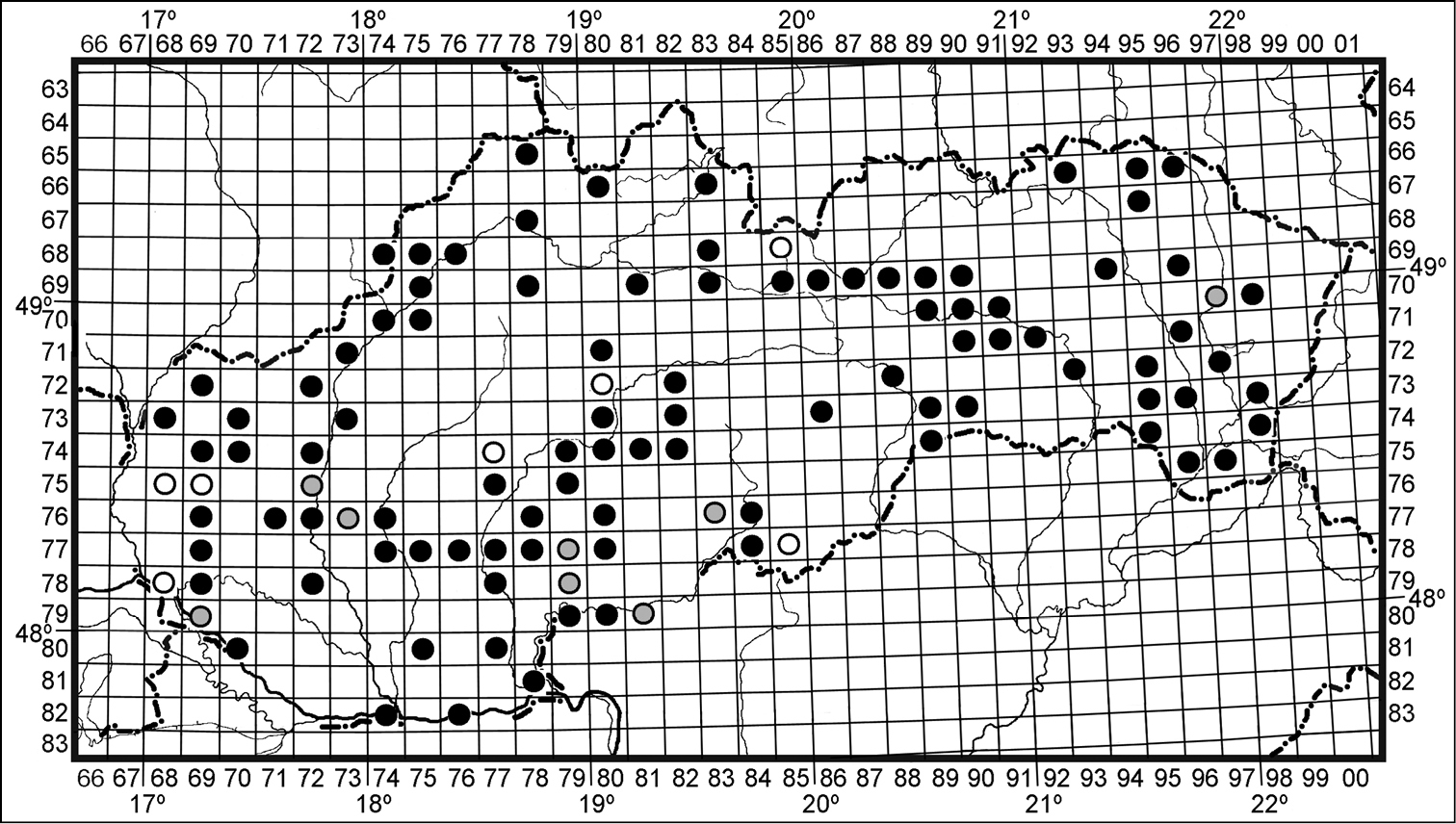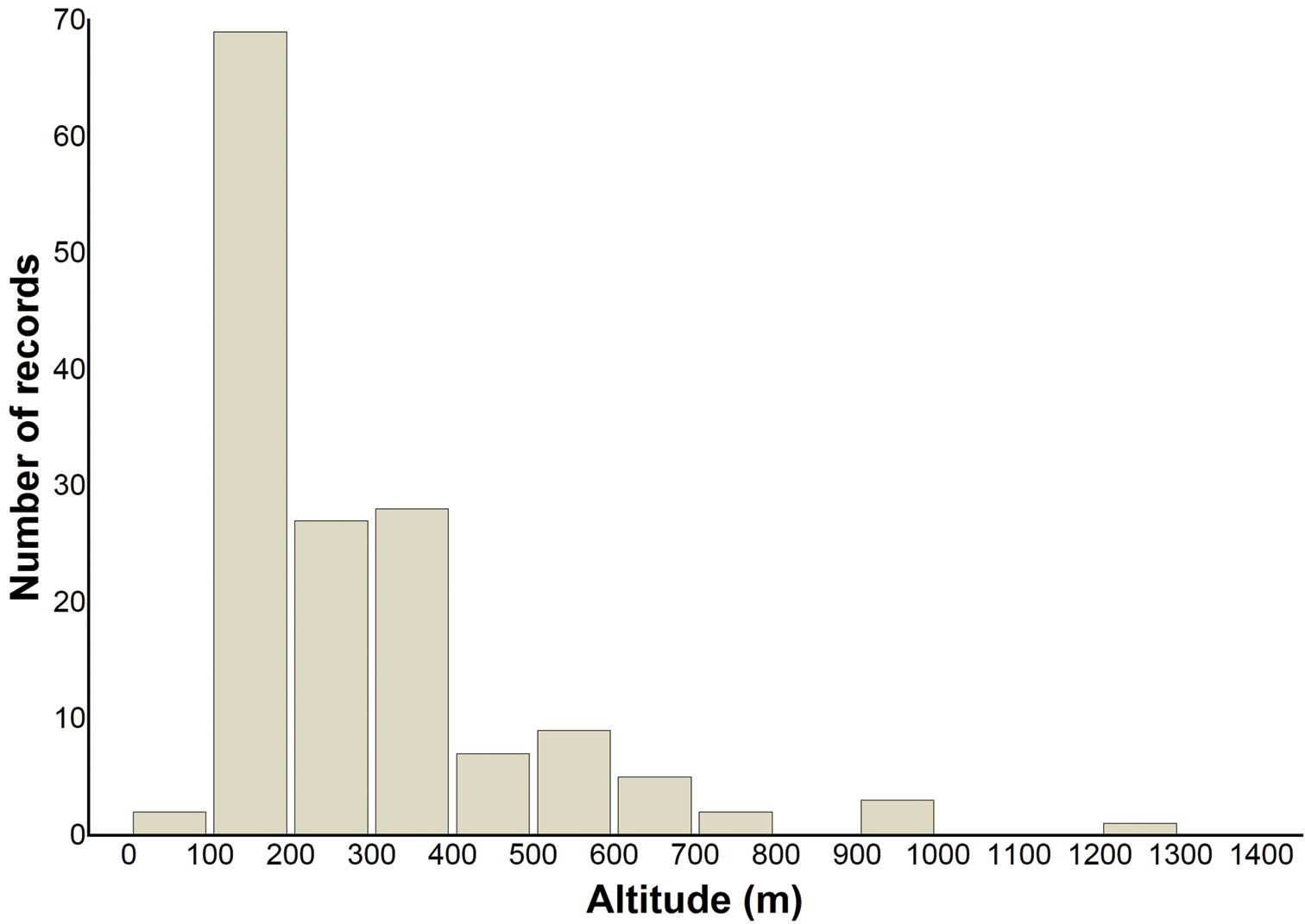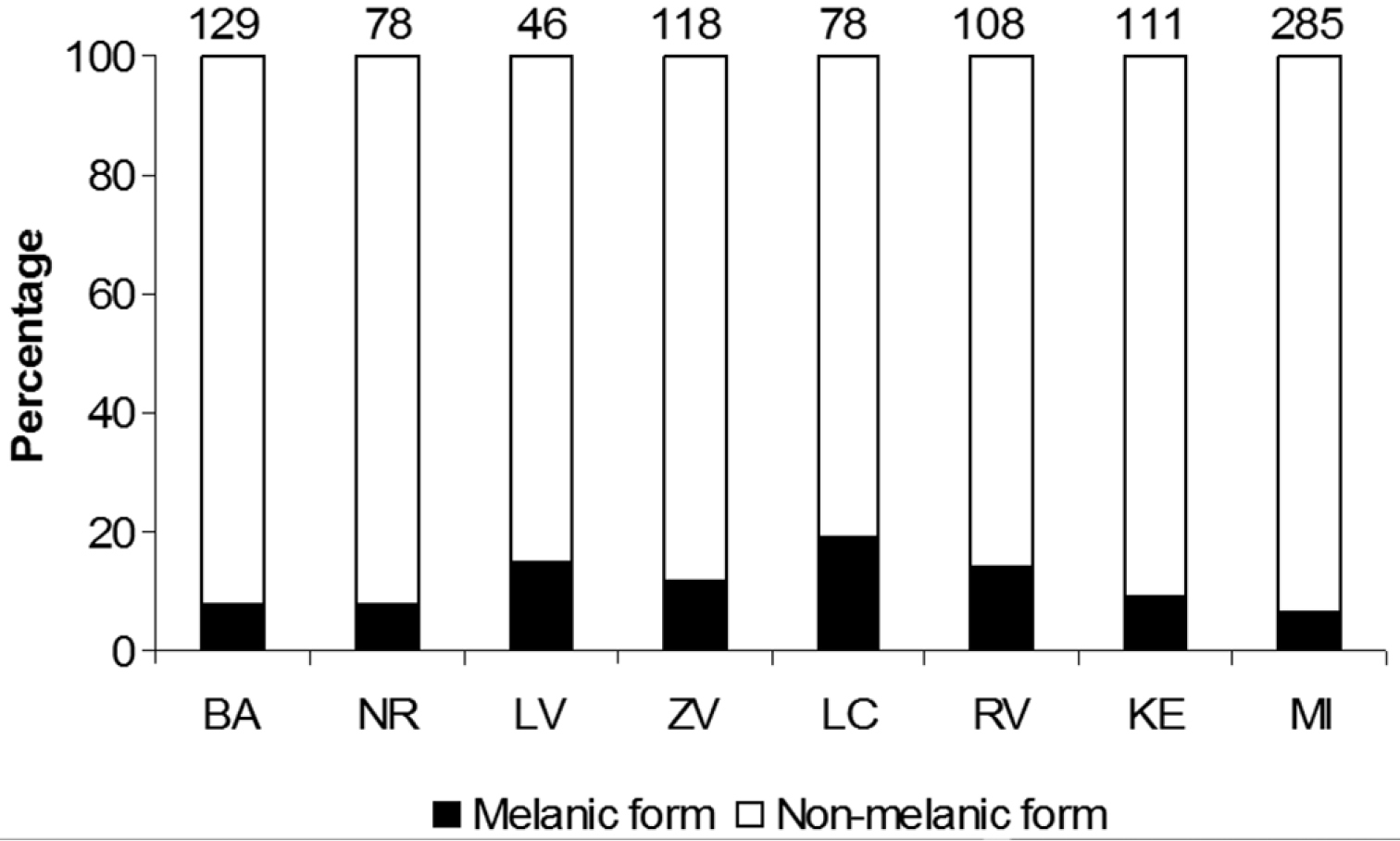






Citation: Panigaj L, Zach P, Honěk A, Nedvěd O, Kulfan J, Martinková Z, Selyemová D, Viglášová S, Roy HE (2014) The invasion history, distribution and colour pattern forms of the harlequin ladybird beetle Harmonia axyridis (Pall.) (Coleoptera, Coccinellidae) in Slovakia, Central Europe. ZooKeys 412: 89–112. doi: 10.3897/zookeys.412.6587
The harlequin ladybird beetle Harmonia axyridis (Coleoptera, Coccinellidae) has invaded and established in Slovakia. Following unintentional introduction in 2008, the spread of the alien coccinellid was very fast. By the end of 2009, it was recorded across the whole country, and by the end of 2012 it was widely distributed and common in various habitats, particularly gardens, orchards and urban areas, where it was most frequent on trees. The rate of eastward spread was approximately 200 km year-1, similar to the overall rate of spread in Europe. Between 2008 and 2012, the coccinellid was recorded in a total of 153 localities, in altitudes ranging from 98 to 1, 250 m. Most records of this species were made in lowlands, hilly areas and valleys separating mountain ridges. However, it was only rarely documented in areas above 700 m a.s.l. The non-melanic colour form (f. succinea) was dominant along a longitudinal transect including eight urban areas across Slovakia, with the frequency of melanic forms (f. spectabilis and f. conspicua together) between 6.3 and 19.2% and a median equal to 10.5%. The invasion history and distribution of H. axyridis in Slovakia are discussed with regard to the time sequence of records, rate of spread, altitudinal distribution, anthropogenic dispersal, effective recording, proportion of melanic forms and other relevant aspects associated with the spread of this successful invader.
Alien, altitude, colour morphs, spatial occurrence, spread
The harlequin ladybird beetle Harmonia axyridis (Pallas, 1773) (Coleoptera, Coccinellidae) is native to eastern and central Asia occurring in Japan, Korea, China, Mongolia, Russian Far East through Siberia to Kazakhstan (
The invasion history and distribution of Harmonia axyridis in some European countries has been detailed in
Adult Harmonia axyridis exhibit a conspicuous colour pattern polymorphism of the dorsal and ventral side (
This study aims to document the spread (longitudinal and altitudinal distribution) of Harmonia axyridis in Slovakia by summarizing the known records of the species collected over the period 2008–2012. Additionally, we document the spatial variation in proportion of the non-melanic and melanic forms of Harmonia axyridis to improve understanding of this globally successful invader.
The occurrence of Harmonia axyridis in Slovakia was recorded over the period 2008–2012 by the authors of this study and other contributors from the Czech Republic and Slovakia, including students of the Pavol Jozef Šafárik University in Košice. The original records collated through the study were supplemented by a few published data (
Larvae and adults of Harmonia axyridis were recorded by observing them on plants or collecting them from vegetation (various habitats) using a sweep net and/or beating tray. In urban areas, they were also knocked down (by hand) from branches of trees and observed on the bare surfaces of pavements or roads. Species presence was also recorded at overwintering sites, mostly in buildings and, quite uniquely in a man-made stony well, occasionally in sheltered semi-natural habitats such as rock piles covered with dry grass. Sampling effort varied within the study, except for in 2012 when a standardized method (described below) was employed. Most grid squares that have no record of Harmonia axyridis (empty in Fig. 1) were not investigated or were sampled randomly with low effort. An exception exists for a few localities for which there were no observations of the species despite intense standardized sampling effort (described below). These negative results are mentioned in the Suppl. material 1.
Distribution of Harmonia axyridis across Slovakia with the time sequence of the 153 records. Map of the Databank of the Fauna of Slovakia in which each “square” is approximately 11 by 12 km. White circles = 2008, grey circles = 2009, black circles = 2010–2012.
The non-melanic (f. succinea) and melanic forms of Harmonia axyridis (f. conspicua and f. spectabilis together) were recorded along a 380 km long transect extending from the west to the east of the country between 30th July and 7th August 2012, in the following eight urban areas: Bratislava, Nitra, Levice (western Slovakia), Zvolen, Lučenec (central Slovakia), Rožňava, Košice and Michalovce (eastern Slovakia). Along this longitudinal transect adult Harmonia axyridis were collected from lower branches of lime trees (Tilia spp.) using a circular beating tray (diameter 1.0 m). A total of 30 samples were obtained in each town where one sample represented the individuals from a total of 20 branches of two to five trees; thus the branches in a total length of 600 m were examined for the presence of the coccinellid in each town. Proportions of colour forms, categorized into the same groups as above, were also estimated independently for eastern Slovakia by pooling the observational records from 2010 and 2011.
The map of distribution of Harmonia axyridis in Slovakia was constructed by combining the following data sources: (1) the database of the University of South Bohemia and Institute of Entomology, Biology Centre AS CR (O. Nedvěd et al. 2008–2012), (2) the database of the Pavol Jozef Šafárik University (Ľ. Panigaj et al. 2010–2012) and (3) the database of the Institute of Forest Ecology, Slovak Academy of Sciences (
The distribution of the records of Harmonia axyridis by altitude was illustrated by a histogram with breaks (altitude ranges) set to 100 m. Frequencies of non-melanic forms of the coccinellid were compared among particular towns along the longitudinal transect (for each combination of towns possible) using the chi-square test (2×2 contingency table) (
A total of 153 records of Harmonia axyridis were made across Slovakia over the period 2008–2012, providing evidence of the occurrence of the coccinellid within 109 squares (11 × 12 km) across Slovakia, i.e. 25.5% of all available squares (Fig. 1, Suppl. material 1).
In 2008, Harmonia axyridis was recorded in seven localities in western, central and northern Slovakia. In 2009, it was known from another eight localities, one of them in eastern Slovakia. Between 2010 and 2012, it was reported from numerous other localities across the entire country. The coccinellid was observed in lowland and submontane areas along the south of the country, extending northwards into long valleys of Váh, Hron and Hornád rivers (Fig. 1).
The majority of records of Harmonia axyridis come from lowlands (up to 200 m a.s.l.) and hilly areas (200–700 m a.s.l.). The records from altitudes above 700 m, and especially those from mountain areas above 1, 000 m a.s.l., are much less frequent (6 and 1 respectively) than those from the lowlands and hilly areas (Fig. 2).
Frequency distribution of the records of Harmonia axyridis from Slovakia, 2008–2012 (n = 153). Data arranged by altitude (m).
Three colour forms (f. succinea, f. spectabilis, f. conspicua) were documented among the 953 adult Harmonia axyridis collected in eight urban areas (towns) located along the 380 km long west-east transect, sampled between 30th July–7th August 2012. The proportion of melanics varied from 6.3% to 19.2% (Fig. 3), with a median of 10.5%. The frequency of melanic forms at Lučenec (19.2%) was significantly different from the frequencies at Bratislava (7.8%) (chi-square test, χ2=4.999, df=1, p=0.025) and Michalovce (6.3%) (chi-square test, χ2=10.846, df=1, p<0.001). Frequencies of melanic forms in the other six towns did not differ significantly from each other (chi-square test, p>0.05). Pooled samples from eastern Slovakia (2010–2011) consisted of a total of 410 specimens, the 59 (14.4%) of which were melanic (f. spectabilis only).
Percentage of melanic f. spectabilis and f. conspicua (combined) and a non-melanic f. succinea among adult Harmonia axyridis (n = 953) in eight urban areas along the 380 km long west-east transect across Slovakia. BA – Bratislava, NR – Nitra, LV – Levice, ZV – Zvolen, LC – Lučenec, RV – Rožňava, KE – Košice, MI – Michalovce. 30th July–7th August 2012
Harmonia axyridis has recently been described as the fastest-spreading invasive alien insect in Europe (
Undoubtedly, Harmonia axyridis has spread very quickly across Slovakia since its arrival in 2008 (
Harmonia axyridis is considered a successful invader (
The spread of Harmonia axyridis may be assisted and, indeed, accelerated by human movement. For example, an adult specimen of the beetle was unintentionally transported in a coach from Prague (western Czech Republic) to Žarnovica (central Slovakia), travelling over the direct distance of 355 km in 7 hours (P. Zach, personal observation). Human-assisted long-distance dispersal, deliberate and inadvertent, has been well-documented in the case of Harmonia axyridis (
The success in recording Harmonia axyridis strongly depends on the establishment and abundance of the beetle in a certain habitat or area. In Slovakia, this semi-arboreal coccinellid (Hodek and Honek 1996) was reported as established immediately after the introduction in 2008 (O. Nedvěd and M. Marko in
In Slovakia, as well as in the Czech Republic (
During field surveys, Harmonia axyridis was recorded in altitudes ranging from 98 m in the south-east to 1, 000 m in the north (foothills of High Tatra Mountains), or as high as 1, 250 m in the central part of the country (Poľana Mountains). Most often, however, it was reported from lowlands, hilly areas and valleys separating mountain ridges, in altitudes bellow 700 m. The low number of records of the coccinellid below 100 m is a consequence of the relief – the lowest point in Slovakia being 94.3 m a.s.l. In contrast, few records were obtained from altitudes above 700 m. This might be a consequence of the possible scarcity of the beetle in higher altitudes and/or difficulty to detect it, especially in inaccessible and not frequently surveyed mountain areas – the highest point in Slovakia being 2, 654 m. It is unclear at the moment as to whether fragmented habitats in mountain ranges dominated by Norway spruce [Picea abies (L.) Karst.] play any role in the active spread of the coccinellid, as documented for native species of coccinellids (
Coccinellids in Central Europe overwinter as adults, often in large aggregations (
The proportion (percentage) of melanic and non-melanic individuals in urban populations of Harmonia axyridis, sampled along the longitudinal transect over a short time period in the summer of 2012, were reasonably consistent, although some spatial variability was evident: the range was 6.3–19.2% and median was 10.5%. The estimate of the percentage of melanic individuals made for eastern Slovakia (14.4%) was within this range. The proportion of melanic forms detected along this transect was somewhat lower than that in Belgium, England and Luxembourg but it was similar to those observed in the Czech Republic (
The detailed observations documented here provide further evidence of invasion by Harmonia axyridis within Europe. The ability of Harmonia axyridis to exploit a range of altitudes provides further insights into the spatial spread of this species. Indeed, the spectacular spread of Harmonia axyridis around the world is testament to the success of this invader. The threat to biodiversity posed by this generalist beetle has been widely recognised (
We thank all the contributors in the appendix for providing us with the data on the occurrence of Harmonia axyridis across Slovakia. The research was funded by the research grants APVV 0200/11 (Slovak Research and Development Agency), VEGA No 1/1025/12, 2/0035/13 and 2/0157/11 (Grant Agency of Ministry of Education and Slovak Academy of Sciences), QH82047 (Ministry of Agriculture of the Czech Republic), 7AMB12SK141 (Ministry of Education, Youth and Sports) and TD1209 (EU COST).
Records of Harmonia axyridis in Slovakia
Ľubomír Panigaj, Peter Zach, Alois Honěk, Oldřich Nedvěd, Ján Kulfan, Zdenka Martinková, Diana Selyemová, Sandra Viglášová, Helen Roy
Data type: occurence
Explanation note: There are records from 2008 to 2012; years 2008 and 2009 marked in bold. The localities (sites of collection) are arranged in alphabetical order. Indicated are the numeric code of the mapping square (see Fig. 1), year of the first record and name of observer. Data on absence of the species are indicated by subsequent records of the species in the same squares or near squares from which it had not previously been recorded (e.g. 2008 – no record, 2009 – first record).
Copyright notice: This dataset is made available under the Open Database License (http://opendatacommons.org/licenses/odbl/1.0/). The Open Database License (ODbL) is a license agreement intended to allow users to freely share, modify, and use this Dataset while maintaining this same freedom for others, provided that the original source and author(s) are credited.


